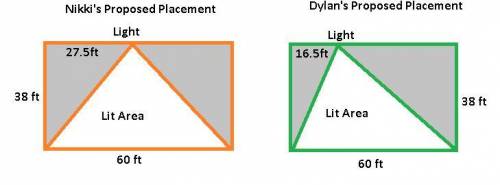
Mathematics, 05.05.2020 01:03 fmyear12
I need help ASAP (only have five minutes)
The Saxena family plans to install a light to illuminate part of their rectangular yard. Nikki and Dylan each proposed a different spot to place the light. The proposed placements and the lit area that each produces are shown below.
Nikki's proposed placemat has a triangular light area with a base of 60 feet and a height of 38 feet. Dylan's proposed placemat has a base of 60 feet and a height of 38 feet.
How do Nikki’s and Dylan’s proposals compare? Check all that apply.
Nikki’s proposed placement will light a greater area than Dylan’s placement.
Dylan’s proposed placement will light a greater area than Nikki’s placement.
Both proposed placements will light the same sized area.
Nikki’s proposed placement will light more than half the yard.
Dylan’s proposed placement will light more than half the yard.
Dylan’s proposed placement will light exactly half of the yard.
Nikki’s proposed placement will light less than half of the yard.

Answers: 3
Another question on Mathematics

Mathematics, 21.06.2019 12:30
Adice is rolled 5 times. how many possible rolls are there? ( determine the number of outcomes using only the fundamental counting principal ) omg bruh can someone me.
Answers: 1

Mathematics, 21.06.2019 15:00
With this question! what is process of elimination? ? p.s. my brothers acc got banned so add his new one @ yamauchiyamyam17
Answers: 2


Mathematics, 21.06.2019 21:30
In a test for esp (extrasensory perception), the experimenter looks at cards that are hidden from the subject. each card contains either a star, a circle, a wave, a cross or a square.(five shapes) as the experimenter looks at each of 20 cards in turn, the subject names the shape on the card. when the esp study described above discovers a subject whose performance appears to be better than guessing, the study continues at greater length. the experimenter looks at many cards bearing one of five shapes (star, square, circle, wave, and cross) in an order determined by random numbers. the subject cannot see the experimenter as he looks at each card in turn, in order to avoid any possible nonverbal clues. the answers of a subject who does not have esp should be independent observations, each with probability 1/5 of success. we record 1000 attempts. which of the following assumptions must be met in order to solve this problem? it's reasonable to assume normality 0.8(1000), 0.2(1000)%30 approximately normal 0.8(1000), 0.2(1000)% 10 approximately normal srs it is reasonable to assume the total number of cards is over 10,000 it is reasonable to assume the total number of cards is over 1000
Answers: 1
You know the right answer?
I need help ASAP (only have five minutes)
The Saxena family plans to install a light to illumi...
The Saxena family plans to install a light to illumi...
Questions










Mathematics, 27.04.2021 22:40


Mathematics, 27.04.2021 22:40

History, 27.04.2021 22:40


Health, 27.04.2021 22:40



Mathematics, 27.04.2021 22:40

Mathematics, 27.04.2021 22:40

Social Studies, 27.04.2021 22:40






